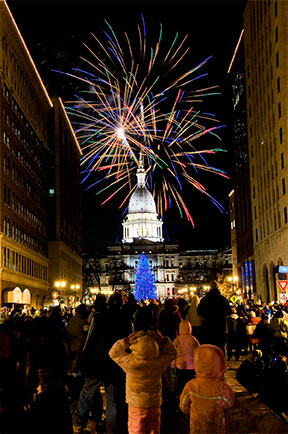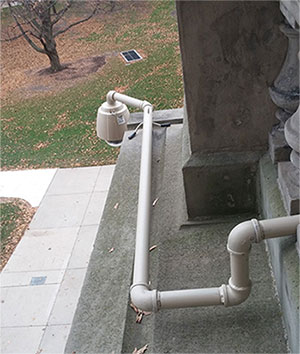Each year in Lansing, Michigan, the holiday season unofficially begins with the Silver Bells Parade. This year, 80,000 people crowded the streets of Lansing on November 22 to see the hour-long parade that ends in front of the Michigan State Capitol building with a traditional tree lighting ceremony. The crowd shouts along with the countdown from ten, the grand marshals throw a giant ornamental switch and the tree lights  are brilliantly illuminated while a giant fireworks display lights the sky.
are brilliantly illuminated while a giant fireworks display lights the sky.
This year, the parade was made safer and more secure by the presence of a newly-upgraded, video surveillance system featuring Samsung IP cameras at the Michigan State Capitol, a fully-operational building that is also a National Historical Landmark maintained by the Facility Department.
“We were determined that we needed additional views in order to increase security at the Capitol,” said Steve Benkovsky, director of the Legislative Council Facilities Agency for the State of Michigan. “Beyond that, we wanted to improve our ability to identify individuals in video.”
Detroit-based, security integrator Camtronics has a long history with the state of Michigan, having handled the original video deployment at the Capitol four years earlier. The company also worked with the Metro Airport, designing systems for their operation, along with the governor’s residence during the Grantholm Administration. Their long-standing relationship was a prime reason for the selection of Camtronics as integrator for the Lansing Tree Lighting project.
According to Mark Wellman, president of Camtronics, because the Capitol building is a National Historical Landmark, adding security cameras to it is a very sensitive issue. It is important that any additions, such as the mounting of security cameras, be planned and executed in a way that will preserve the historical appearance of the building. Compounding the challenges, the building’s illumination was designed with spotlighting to enhance the historic appeal of the building – which makes it less than ideal for identification of individuals at night in a security application.
“We provided all of the technical expertise for systems requirements and coverage, and helped the team at the state capital by recommending solutions that could easily be worked in to certain types of architecture,” said Wellman. “At the same time, we made sure that nothing compromised the view they needed or the video recording they expected out of these cameras and their positions.”
Samsung IP cameras were Camtronics’ recommendation for the deployment, rather than continuing to utilize cameras from the manufacturer which had been used for the original video surveillance system at the building. According to Wellman, the switch was made primarily for the superior image quality delivered by the Samsung cameras.
 “There was a high expectation for performance on these cameras,” said Wellman. “The capital and state police had very specific criteria that they were looking to fulfill, such as the ability to see at night and to clearly identify faces – especially because the lighting was designed to enhance the historic appeal of the building. So essentially, we needed cameras that could still provide us clear images, good detail and resolution of people in the crowd in spite of the fact that it had to contend with monument-style lighting around the building.”
“There was a high expectation for performance on these cameras,” said Wellman. “The capital and state police had very specific criteria that they were looking to fulfill, such as the ability to see at night and to clearly identify faces – especially because the lighting was designed to enhance the historic appeal of the building. So essentially, we needed cameras that could still provide us clear images, good detail and resolution of people in the crowd in spite of the fact that it had to contend with monument-style lighting around the building.”
One year earlier, a third manufacturer’s IP cameras had been put up temporarily at the building for a specific event. Wellman relates that according to reports, detail was so obscured by the cameras’ inability to handle that type of lighting in the darkness, the video was rendered useless.
“They weren’t able to make out faces or details of anyone in the crowd,” said Wellman. “There was nothing but glare from the lights.”
The video quality from the Samsung cameras did not have that problem.
“In one instance, there is a camera looking right at one of the ornate light fixtures, and you can still clearly read the sign 20 feet behind it on the ground,” said Wellman. In fact, out of the cameras that we have installed and looked at to potentially install, we are moving closer and closer to making Samsung our proprietary line.”
The temporary cameras were taken down after the event, and the current cameras in place on the Capitol building will be replaced in time by Samsung cameras as well.
Camtronics installed new Samsung cameras including five SND-5010s, four SND-5080s and five SNP-6200Hs on one of the Capitol building’s balcony areas, maintaining Ethernet IP communications from all the new Samsung cameras back to the head end. The only analog units remaining are the original cameras, which work through an encoder. Several of the cameras mounted on the building’s exterior utilize fiber and media converters to accommodate for distance and environmental concerns including water leakage, chemicals, etc. The cameras provide coverage on the east side of the building to view rallies and events on the front lawn.
“That’s why we suggested putting fiber across media converters to their main switch which was provided by the capital – we provided the server with expandable storage and the VMS platform,” explained Wellman.
The installation has numerous unique qualities. The sandstone exterior of the 143-year-old state capitol building is original, requiring great care in mounting each camera. The on-site team – including Mark McEwan, maintenance mechanic; Bob McDonald, assistant facility manager and Benkovsky – made each mount by hand.
“There was a lot of personal effort and soul put in to making those mounts,” said Wellman. “In some cases, the gentlemen that made them were taking them home at night and crafting them in their garages.”
Wellman explains further, “There was a need to make the cameras swivel upward so they would be easy to maintain. They also wanted to have them anchored to the existing light brackets, so there wouldn’t be any need for holes to be put into the building. So, if the cameras ever had to be removed, there would be only small holes that could easily be filled in with grout. The mount had to go out through the railing of the balcony, drop down so it would be hidden a little bit and then go over to the corner of the building and be able to be picked up without hitting the pillars of the next balcony.”
McEwan designed the mount that made this possible, using a 1 ½-inch thick, 10-foot-long, galvanized pipe that had enough weight to hold the cameras up and maintain its position, even in windy conditions.
 In addition, in designing the mounts, it was important to consider how the cameras could be serviced if needed. With that in mind, McEwen created a leverage bar that could raise a section of the mount back up. In addition, he added a bracket and a footing to the mount so that the camera could rest on the mount without having to lie directly on the rail and without running the risk of hitting the sandstone. This section was made of a stainless steel rod and a rubber hose. Finally, in order to ensure that the mounts do not move, the joints were brazed.
In addition, in designing the mounts, it was important to consider how the cameras could be serviced if needed. With that in mind, McEwen created a leverage bar that could raise a section of the mount back up. In addition, he added a bracket and a footing to the mount so that the camera could rest on the mount without having to lie directly on the rail and without running the risk of hitting the sandstone. This section was made of a stainless steel rod and a rubber hose. Finally, in order to ensure that the mounts do not move, the joints were brazed.
The final step in completing the creation of these mounts was for the decorative painter to mix the precise paint color that would blend into the design and décor of the historical sandstone building.
According to Wellman, the final result not only met, but exceeded, expectations.
“The installation, which was a collaborative venture, was rewarding for all parties involved,” he said. “For the Silver Bells Parade, they had images which were ‘outstanding and crisp,’ with good views even during the night lighting around the Capitol.”
In all, it was a holiday gift of improved security that will keep giving into the future.